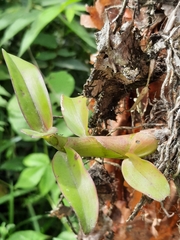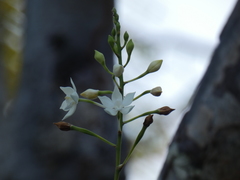

|
|
|
|
Family: Orchidaceae
[Diacrium bilamellatum (Rchb.f.) Hemsl., moreDiacrium bilamellatum var. reichenbachianum Schltr.] |
Diacrium bilamellatum (Reichb.f.) Hemsl. Epiphyte, 20-65 cm tall; stems pseudobulbous, fusiform to cylindrical, to 16 cm long, hollow and often inhabited by ants, enveloped by close, short bracts, bearing 1-4 strap-shaped leaves at apex. Leaves conduplicate, 6-20 cm long, to 2.5 cm wide. Inflorescences terminal, few-flowered, long-pedunculate racemes; peduncles 5-45 cm long, bearing numerous short sheaths; flowers white or pink, often cleistogamous, pedicellate, 1 or few open at a time; sepals 11-16 mm long, slightly longer and narrower than the petals, thickened toward apex, equaling lateral petals; lip free from the column, with 2 horns on upper side near base. Fruits elliptic, ribbed capsules, 2.5-3 cm long at maturity. Croat 7762, 8709. Occasional over trees at the margin of the lake, and infrequent within the forest. Flowering chiefly in February and March (rarely into the early rainy season). The fruits develop to full size by March, and seeds are usually shed by late in the dry season. Mexico to Panama and across northern South America to Trinidad. In Panama, a lowland, principally coastal species known from tropical moist forest in the Canal Zone, Bocas del Toro, Colón, and Chiriqui, Panama, and Darien and from tropical wet forest in Colón, Bocas Species Database Habitat: Large shade trees growing in populated areas Distribution: Provincia de Bocas del Toro |



























